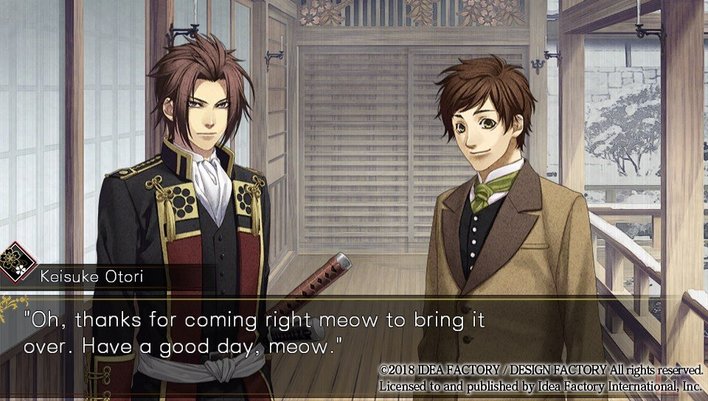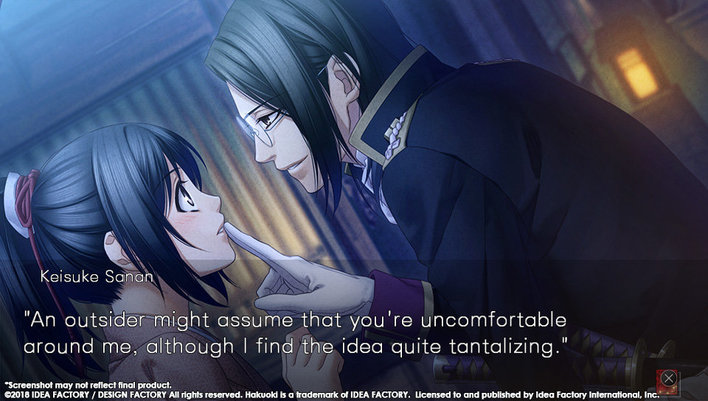It may be a month since Valentine's Day now, but love is very much in the air on the Playstation Vita this month, albeit in a ye olde Japanese fashion. As a long time fan of both romantic otome games and visual novels, we were more than a little excited about the news that the epic conclusion to last year's samurai-romancing saga, Hakuoki, would be hitting the Vita, this year bringing with it a whole slew of extra content to sink our teeth into. And with the recent weather we've been having, having an engrossing story to curl up with was just the ticket - and as the snow piled up outside our window, we set about working our way through the ranks of the Shinsengumi, one buff samurai at a time.

Nagakura finally gets his own route too!
The sequel to last year's Hakuoki: Kyoto Winds, Edo Blossoms is a game about romance - although its overarching plot may not make that immediately obvious. Continuing the tale of the Shinsengumi (kind of like a samurai police force) in 1860s Japan, at a time of great political turmoil, the game follows said Shinsegumi's relocation from Edo as military tensions in Kyoto escalate, covering the sad, slow decline and fragmentation of the organisation, and the betrayals, deaths and disorder that come with being on the losing side in the battle over Japanese traditionalism. However, this isn't exactly a historically accurate retelling, instead told from the perspective of a young girl, Chizuru Yukimura, whose quest to find her missing father has led her to be taken in by the Shinsengumi for protection, as she somehow manages to attract the attention of a group of powerful demons in the process. Suffering from a particularly bad case of Stockholm Syndrome, it doesn't take long for Chizuru to start developing feelings for the men of the Shinsengumi, as she begins to uncover some dark secrets from her past.
As for where Edo Blossoms actually fits in with the series so far - well, that'll take a bit of explaining. Essentially, this is the same Hakuoki story we've played through several times already - on the PS2 (Japan-only original), PSP, the PS3 and the 3DS to be exact - albeit in a much more expanded form. Together, last year's Vita game (Kyoto Winds), and this one (Edo Blossoms) cover the same eight or so chapters of the original PS2 game, with Kyoto Winds stopping, and Edo Blossoms picking things up at roughly the half way point, as the action shifts from Kyoto to Edo and beyond. However, because of the way the games have been split, the structure has changed a little.
In the original games (i.e., the PS2, PSP, PS3, or 3DS), the first four or so chapters stayed pretty much the same, no matter which path you ended up on, with just a handful of short character-specific scenes dependant on certain conversation choices and affection levels. At around chapter four, the story then branched off, taking you towards a number of different endings, dependant on which of the eligible bachelors you had the highest affection with. For the Vita games, however, Kyoto Winds somewhat weirdly only went up to chapter five, with the story left as "to be continued" in Edo Blossoms. What this meant in practice was that playing Kyoto Winds was a case of going through same first four chapters multiple times, with only minor differences between each branch, before getting to see just the very beginnings of the blossoming romances between the protagonist Chizuru and her chosen fella, as the game ended somewhat abruptly only a chapter or so into the route. Edo Blossoms, however, is a totally different beast. Rather than carrying over your save, you instead pick your preferred guy from the line-up right from the off, with each story being more of a self-contained tale. As such, despite having fewer chapters in total, Edo Blossoms actually feels like there's much more to it than its predecessor, with much less in common between your playthroughs. Which is nice.

Knowing the right thing to say at the right time is the key to wooing the samurai of your dreams.
The same twelve bachelors from Kyoto Winds carry over into Edo Blossoms too, with some "alternate ending" style routes (Yamazaki and Sakamoto in particular) that are fun to get into. You have the original six of 'demon' commander Hijikata, the (sickly) sword of the Shinsengumi Okita, quiet and mysterious Saito, Harada the ladies' man, friendly Heisuke and demon clan leader Kazama, who won't take no for an answer. They're joined by a handful of Shinsengumi members who got overlooked the first time around - namely ninja medic Yamazaki, boisterous Nagakura and studious Sanan - along with a few new faces too: Souma, a fairly new recruit (and fanboy) to the Shinsengumi, Iba, a member of the Shogun's Okuzume guard, and Sakamoto, a potential enemy of the Shinsengumi.
They've really done justice to the new characters' routes too, giving them proper fully-fledged stories to play through that are as long and as detailed as some of the oldies we've romanced several times before, packed with plenty of twists and turns, revelations about Chizuru's past and betrayal, along with deaths and descents into madness a plenty. Even the old guys get a handful of new scenes and events too, giving you another reason to romance Harada for the umpteenth time, or save Okita from himself once more. With a dozen routes to play through, Hakuoki: Kyoto Winds/Edo Blossoms is arguably one of the biggest otome visual novels going, and the fact that some of our favourite overlooked characters now have their own routes is even better.

Newcomer Souma's route may be a bit of a sad one, but it does have its funny moments too.
Once you've picked your guy, Edo Blossoms plays very much like Kyoto Winds before it, as you take in the long and winding tale of the slow demise of the Shinsengumi, with a focus on a particular guy's part in its downfall. Every so often, you'll get to a point in the narrative where you're faced with a decision - perhaps a choice of reply to a particular guy, or the need to intervene in a situation - where the right choice will endear you even further to your bachelor, while the wrong choice could have dire consequences further down the line.
This is especially important with regards to a new factor that comes into play in the latter half of the story - corruption. Depending on your choice of guy, and the point at which you are through the story, they may or may not have drunk a dangerous concoction called the Water of Life, which turns them into a super-powered demon-like version of themselves. The only problem is, with the increased power comes a pretty hefty thirst for blood. Chizuru often has the option to feed them some of her blood to try and help the pain of the bloodlust subside - but if you don't fancy enabling an addict, you can choose to try to lessen the symptoms with medicine, or force them to power through the pain without. Managing the bloodlust is key to getting a good ending with your chosen bachelor, as if their corruption gets too high, they'll be overcome with a lust for blood, go crazy and (most likely) kill Chizuru where she stands, giving you a game over.
In fact, about the only real issue with Hakuoki: Edo Blossoms is the odd divide between the two games. The fact that the game (for one reason or another) had to be split in half, effectively severing the stories part way through can leave things feeling a little fragmented, especially as the stories in Kyoto Winds ended up finishing on a bit of a cliffhanger. Edo Blossoms does try its best to bring you up to speed on what happened previously, with each bachelor having a short prologue before things get going, but it can still be a little tricky to remember all the circumstances that have gone before in each route, particularly in the case of which characters are still alive, or how key face-offs and battles turned out. If you got on the Hakuoki train early, like us, you'll have had a year between Kyoto Winds and Edo Blossoms, meaning the details all end up a bit of a blur - much more so than if you were to come late to the party, and, say, romance Hijikata on Kyoto Winds now, then move straight on to Edo Blossoms to pick up without a break. If you ask us, it would have made more sense to give you six complete bachelor routes on one installation, and six complete routes on the other.

While we'd previously dismissed him as a bit of a creep, Sanan's route was a bit of a surprise in the end.
In all, then, it's a bit hard to know what to say about Hakuoki: Edo Blossoms, really. If you're just getting started with the Hakuoki saga, you probably shouldn't start here, as a knowledge of the story, events and characters in the first game are pretty much essential. But, when considered as the second part of a whole with last year's Hakuoki: Kyoto Winds, Edo Blossoms is very much the definitive Hakuoki experience, stuffed with enough new content, characters and bachelors that it's much more than just another remake - this is more like Hakuoki 1.5. As much as we would like a brand new Hakuoki game, the combo of Kyoto Winds and Edo Blossoms is enough to keep us going for the foreseeable future at least, as we set about romancing our way through the Shinsengumi ranks in what is arguably one of the best otome visual novels so far.
Format Reviewed: PS Vita




















